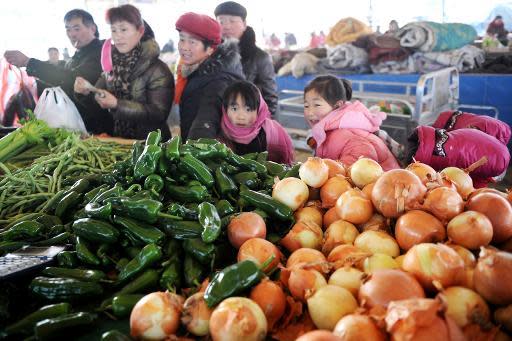China inflation jumps to 2.4% year-on-year in March

Beijing (AFP) - Chinese inflation accelerated to 2.4 percent year-on-year in March driven by higher food prices, official data showed Friday, though economists warned there was still a risk of deflation.
The rise in the consumer price index (CPI) was up from the 2.0 percent seen in February but well below the 3.5 percent annual target set by Beijing and adds to unease about the economy after Thursday's disappointing trade data.
It was also marginally below the median forecast of 2.5 percent in a survey of 16 economists by Dow Jones Newswires.
The increase was chiefly driven by a 4.1 percent year on year increase in food prices, the National Bureau of Statistics (NBS) said in reporting the figures.
February's weak result had prompted economists had warn that there was a growing risk of deflation in the world's second-largest economy. And after the latest data, they said that threat remained.
The NBS said the producer price index (PPI) fell 2.3 percent in March, accelerating from February's 2.0 percent slip.
The PPI result indicates "weak demand for manufacturing goods", ANZ Bank economists Liu Li-Gang and Zhou Hao said in a research note.
"As the PPI inflation remained negative for more than two years and PPI is an important leading indicator for CPI, the deflation risk is looming over the horizon," they said.
Moderate inflation can be a boon to consumption as it encourages consumers to buy before prices go up but economists say falling prices encourage consumers to put off spending and companies to delay investment, both of which act as brakes on growth.
"A seasonal pick-up in food inflation in March does little to change China's broader inflation outlook," Julian Evans-Pritchard, China economist at Capital Economics wrote in a reaction to the data.
China's CPI, a main gauge of inflation, rose 2.6 percent in 2013, unchanged from 2012.
Leaders in Beijing say they want to wean the economy off investment as the key growth driver and shift the focus to consumer spending.
The country's gross domestic product grew 7.7 percent last year, the same as in 2012 -- the slowest rate of growth since 1999's 7.6 percent.
The last time GDP was any lower was in 1990, when it was measured at 3.8 percent.
Chinese Premier Li Keqiang last month announced a growth target of "around 7.5 percent" for 2014.
Official data on Thursday showed Chinese exports and imports both fell sharply in March, potentially another worry following a string of downbeat indicators indicating a slowdown in the Asian economic giant and key driver of global growth.
Imports slumped 11.3 percent year-on-year to $162.4 billion while exports fell 6.6 percent to $170.1 billion, the General Administration of Customs announced, resulting in a surplus of $7.7 billion. Economists had expected both to grow.
Li, speaking Thursday at a political and economic forum that China hosts annually, appeared to shrug off concerns.
"The Chinese economy is off to a stable and good start," he said, according to the Xinhua news agency.


